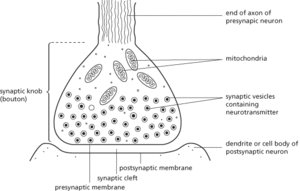The junction between two adjacent neurons (nerve cells), i.e. between the axon ending of one (the presynaptic neuron) and the dendrites of the next (the postsynaptic neuron). In chemical synapses the swollen tip of the axon of the presynaptic neuron, called the synaptic knob (or bouton), contains vesicles of neurotransmitter substance. At a synapse, the membranes of the two cells (the pre- and postsynaptic membranes) are in close contact, with only a minute gap (the synaptic cleft) between them. A nerve impulse is transmitted across the synapse by the release from the presynaptic membrane of neurotransmitter (see snare), which diffuses across the synaptic cleft to the postsynaptic membrane. This may trigger the propagation of the impulse from the dendrite along the length of the postsynaptic neuron. Depending on their type, most neurons give rise to multiple synapses with other neurons or effector organs (e.g. muscles) and themselves receive inputs from many hundreds or thousands of synapses. The signals received or sent can be excitatory or inhibitory (see summation). Much less common are electrical synapses, in which ions flow directly from one neuron to another via gap junctions. These are found, for example, in the heart and in certain parts of the vertebrate central nervous system. Such an arrangement ensures virtually instantaneous transmission of impulses. During development many superfluous synapses formed in the early embryo are eliminated by a process called synaptic pruning. This ensures that only functionally relevant and active synapses persist into adulthood. See also active zone; excitatory postsynaptic potential. Compare neuromuscular junction.

Structure of a synapse
http://thebrain.mcgill.ca/flash/a/a_01/a_01_m/a_01_m_fon/a_01_m_fon.html#2 Multilevel summary of synaptic function, sponsored by the Canadian Institutes of Health Research
- Raup, David Malcolm
- RAVAN
- raven
- ravens, paradox of
- Ravenstein’s ‘laws’ of migration
- ravinement surface
- ravine wind
- raw data
- raw error rate
- rawinsonde
- Rawlings, Jerry (1947–2020)
- Rawlsian social welfare function
- Rawls, John (1921–2002)
- raw materials
- Rawtheyan
- RAX
- ray
- ray casting
- Ray, John
- Rayleigh criterion
- Rayleigh distribution
- Rayleigh equation
- Rayleigh fading
- Rayleigh, John William Strutt
- Rayleigh limit